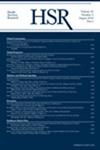Evaluation of regional variation in racial and ethnic differences in patient experience among Veterans Health Administration primary care users
Abstract
Objective
To evaluate racial and ethnic differences in patient experience among VA primary care users at the Veterans Integrated Service Network (VISN) level.
Data Source and Study Setting
We performed a secondary analysis of the VA Survey of Healthcare Experiences of Patients-Patient Centered Medical Home for fiscal years 2016–2019.
Study Design
We compared 28 patient experience measures (six each in the domains of access and care coordination, 16 in the domain of person-centered care) between minoritized racial and ethnic groups (American Indian or Alaska Native [AIAN], Asian, Black, Hispanic, Multi-Race, Native Hawaiian or Other Pacific Islander [NHOPI]) and White Veterans. We used weighted logistic regression to test differences between minoritized and White Veterans, controlling for age and gender.
Data Collection/Extraction Methods
We defined meaningful difference as both statistically significant at two-tailed p < 0.05 with a relative difference ≥10% or ≤−10%. Within VISNs, we included tests of group differences with adequate power to detect meaningful relative differences from a minimum of five comparisons (domain agnostic) per VISN, and separately for a minimum of two for access and care coordination and four for person-centered care domains. We report differences as disparities/large disparities (relative difference ≥10%/≥ 25%), advantages (experience worse or better, respectively, than White patients), or equivalence.
Principal Findings
Our analytic sample included 1,038,212 Veterans (0.6% AIAN, 1.4% Asian, 16.9% Black, 7.4% Hispanic, 0.8% Multi-Race, 0.8% NHOPI, 67.7% White). Across VISNs, the greatest proportion of comparisons indicated disparities for three of seven eligible VISNs for AIAN, 6/10 for Asian, 3/4 for Multi-Race, and 2/6 for NHOPI Veterans. The plurality of comparisons indicated advantages or equivalence for 17/18 eligible VISNs for Black and 12/14 for Hispanic Veterans. AIAN, Asian, Multi-Race, and NHOPI groups had more comparisons indicating disparities by VISN in the access domain than person-centered care and care coordination.
Conclusions
We found meaningful differences in patient experience measures across VISNs for minoritized compared to White groups, especially for groups with lower population representation.


 求助内容:
求助内容: 应助结果提醒方式:
应助结果提醒方式:


